Jackson Hole Elk Hunt – Nat'l Elk Refuge

- Fall 2022: bagged a ~400lb cow elk in the National Elk Refuge (Jackson Hole, WY), shortly before Thanksgiving.
- Early season snowfall drove earlier migrations from the Nat'l Park / Forest.
- 308 Lever Action rifle with copper 150-grain bullets.
- Harvested on third day hunting; first day in Area 85 near Taylor Mountain; second day in the Elk Refuge, pursuing a small herd of cows with no luck.
- See also: How to Tan an Elk Hide with Hair-on.
Note: I may get commissions for purchases from certain links in this post.
My First Hunt
Fall 2022 was my first proper hunt.
I grew up in the suburbs of New York. My Dad hunted whitetail deer in the Catskills / Eastern Long Island, but we spent more time fishing – mostly stripers and bluefish on the South Shore. My one unsuccessful hunting trip with my Dad yielded a nasty case of poison ivy, souring me on east-coast bushwhacking.
Over my first year in Jackson, friends offered up elk steak dinners, dishes at potlucks and jerky on hikes. I was jealous of that high-quality meat and inspired by Edmund Morris's Teddy Roosevelt bios.
Lacking gear and know-how, I doubted 2022 would be my season. But I signed up for a hunter safety course in July, just in case.
In Wyoming, hunter education is a prerequisite to hunt with firearms. Wyoming Fish & Game organizes a number of courses throughout the State. Jackson Hole Gun Club hosts the closest courses to Jackson.
In August, a friend offered to lend me his rifle, glasses and hunting backpack for the season. His freezer was still full from a 2021 hunt, so he decided to skip fall 2022. I jumped at his offer and got serious about the fall.
Prerequisites to Hunt in Wyoming
In Wyoming, potential hunters need:
- If using a firearm, Hunter's Safety Course (unless born before 1966 or a veteran / WY peace officer); equivalent courses from other states valid
- License for their target animal (e.g., elk tag)
- Conservation Stamp (some exemptions)
- For special management areas like the Elk Refuge, a Permission Slip
- For select hunt areas in northwest Wyoming, an Elk Special Management Permit (funding winter feed ground costs)
- For nonresidents pursuing big game (including elk) or trophy game, a professional outfitter or resident guide
- One item of fluorescent pink / orange clothing
Full requirements available here.
Hunter Safety Course
Wyoming Hunter Safety Courses run 12-18 hours over 2-5 days. My course was scheduled for 14 hours over four evenings (6-9:30pm), but ended up being 12 hours with early breaks. The State also offers a part-online course.
The curriculum covers:
- Hunter Responsibility and Ethics
- Wildlife Conservation and Management
- Firearms and Firearm Safety
- Game and Fish Statutes and Regulations
- Game Care and Wildlife Identification
- Outdoor Safety
Our group of ~12 students included adults and young hunters with their parents. We gathered in a classroom at the Jackson Hole Gun Club each night for a mix of lecture, discussion, videos and guest presentations from local law enforcement / Fish & Game officials.
Our class wrapped with a two-part exam: closed-book multiple choice and firearm handling, using plastic, mock weapons. The handling portion included identification of rifle types (lever action, pump, bolt, etc.) and safe handling practices (always pointed in a safe direction, check if unloaded, etc.).
Upon passing the exam, our volunteer instructor handed out temporary certificates and a blaze orange pronghorn patch.
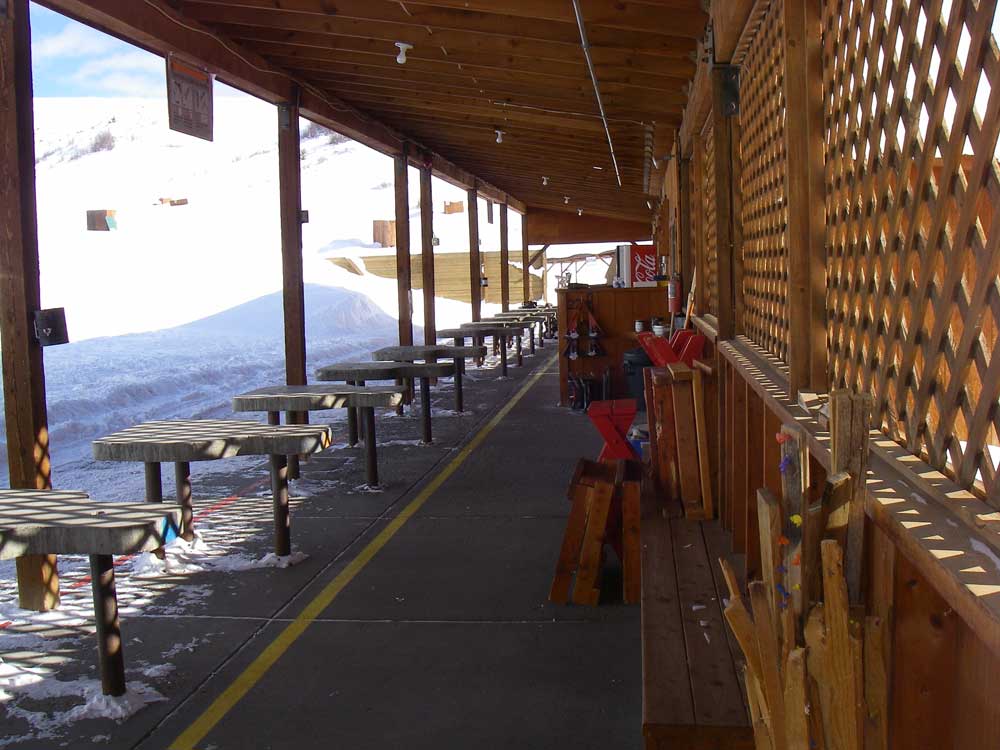
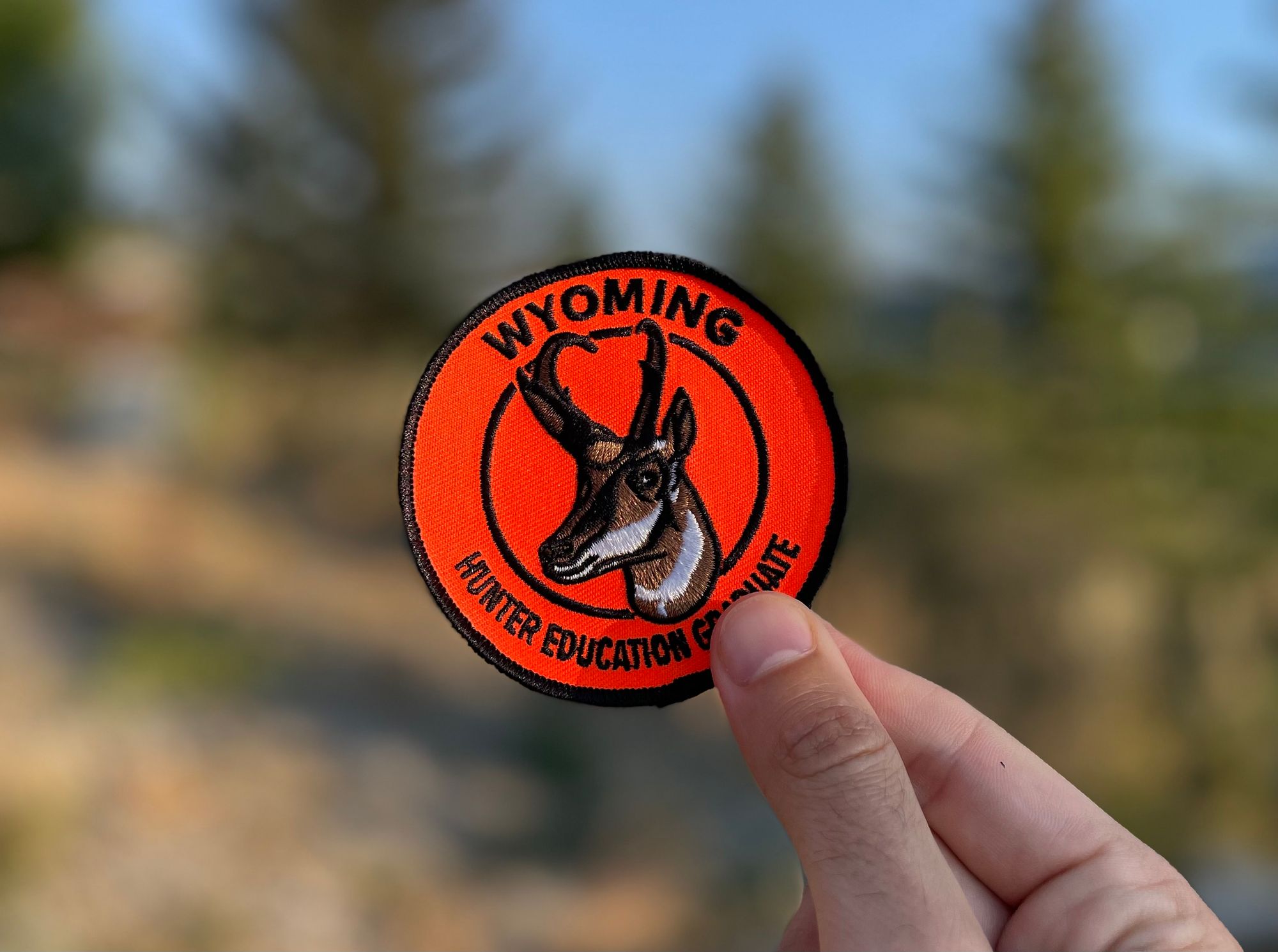
Jackson Hole Gun Club (left); Hunter's Safety patch (right)
Licenses, Stamps and Permits, Oh My
I applied for a few specific tags in spring 2022, but didn't win any lotteries. A resident can buy one general tag for more limited use throughout the State's hunt areas and on the Elk Refuge with a separate Permission Slip. By winning lotteries for other tags, hunters can get earlier access / later hunting windows and additional elk (up to three per season).
Check out the full 2022 regulations and interactive area map for more context.
For my purposes, a ~$60 resident general tag would do the trick. Nonresident fees are significantly higher. See the full fee roster here.
I had a conservation stamp through October from my annual resident fishing license, so I just needed to extend before any November hunting. I picked up a new annual stamp for $12.50 and an Elk Special Management Permit for $15.50 at the Fish and Game office next to the Visitor Center in Jackson.
My plan, informed by a friend's experience, was to start with Hunt Area 85 in October, then fall back on the Elk Refuge if I didn't have any luck.
To cover my bases, I applied for a couple Refuge Permission Slips in December. Slips are offered in increments of a few days each. Elk usually migrate into the Refuge with the first significant snowfall in late November, so I thought early December was a safe bet.
Preparation
Legal requirements out of the way, it was time to line up the gear.
My buddy offered to join me at the informal Flat Creek shooting range. It's an area in Bridger Teton Nat'l Forest with natural shooting backdrops (rolling hills), accessed via Elk Refuge access roads.
I picked up 150-grain lead (for practice) and copper (for the hunt) bullets. Lead bullets are cheaper, but leave toxic fragments that can poison birds like eagles, ravens, etc., as they scavenge gut piles.
We placed paper targets at 200 and 400 yards. I shot the 308 standing, kneeling and prone. I mostly used lead ammunition, but also tried a few copper. I comfortably hit the "dinner plate" at 200 yards. Elk vitals (heart and lungs) are roughly the size of a dinner plate. At 400 yards, I was less consistent.
In the spirit of an ethical hunt, I needed to stalk within 200 yards. The last thing I wanted was a gut shot, resulting in a wounded animal or slow kill.
I pulled together the following gear before day one:
- 308 lever action rifle with scope
- 150-grain copper ammo
- Camo backpack with a large mesh compartment for quarters; hunters usually field dress an elk into four quarters (each leg), plus the tenderloin, rib meat, neck meat, etc.; a whole carcass is too heavy to carry
- Binoculars or glasses (for spotting) and a range finder (to check distance before taking a shot; in my case <200 yards)
- Cow elk caller to mask my footsteps, as needed
- Camo chest holster for glasses, range finder and caller
- Field dressing tools: hunting knife and a field sharpener, latex gloves, paracord to separate / suspend legs as needed, breathable mesh game bags to keep quarters clean and zip ties
- Paperwork: general elk license, conservation stamp, elk special management permit, Refuge permission slip and hunting map, and hunter safety card (had it printed and laminated at Staples)
- CWD test kit for the lymph nodes (more info here)
- Blaze orange ballcap, beanie and vest
- Bear spray
- First aid kit and tourniquet, especially important on the Refuge with heavy hunting traffic
- Emergency gear: space blankets, lighter, fire-starter, hand warmers, gorilla tape, Leatherman multi-tool, etc.
- Nose Jammer scent-masking spray, deodorant and body wash (I doubt this made much of a difference given my noisy stalking)
- Water and calories (GU gels and some bars)
- Layers: base, camo long-sleeve shirt, sweater, puffer, etc.
- Garmin inReach for safety; also to message friends who volunteered to help pack out quarters (can only carry one at a time otherwise)
- Suitable shoes / boots for hiking with weight on pack; used Sportiva TX4 approach shoes from summer climbs
As a newbie, I studied some key aspects of elk hunting before hitting the field:
- Elk behavior (e.g., night feeding and day bedding)
- How to stalk (accounting for sight, smell, wind, etc.)
- How to quarter an elk (some good videos here and here); tip: you can quarter an elk without removing the guts and still retrieve the tenderloin (required)
- How to gut an elk (in case of a close shot on the Refuge)
- How to extract lymph nodes for CWD testing (more here); Game & Fish also maintains head drop-off bins, but I wanted to be prepared for lymph nodes in case I bagged a bull and wanted a European mount
- Cuts of meat; I didn't have the gear / space to butcher the elk myself, but wanted to understand where different cuts came were sourced
Some risk factors I considered:
- Bear safety: increased risk of encounters due to (1) masked scent and noise during the stalk and (2) during quartering, attractants drawing in black bears and grizzlies; during quartering, I planned to keep my rifle and bear spray readily accessible; and between trips, I'd aim to hang quarters in a spot visible from a nearby ridge, so I could glass for predators before the final approach
- Gun safety: I was confident in my own firearm handling (grew up in a law enforcement family, so educated from an early age), but there's always risk from other hunters; Area 85 sees less traffic due to the approach; Refuge is busier, so I planned to hunt hills in the north with natural backdrops that reduce risk of stray bullets; I also had a tourniquet and satellite phone
- Other injury: whenever I'm in the backcountry, I'm prepared to spend the night (space blankets, fire tools, etc.)
I ran my first marathon at the end of September and needed a week to recover. With two east coast weddings in mid-October, I had one week to hunt Area 85. General tag access closed on the 31st. I wouldn't be back until early November.
I planned to hit the trail on October 7th before sunrise, ascending Taylor Mountain to glass for elk in surrounding terrain. On the night of the 6th, I rewatched a couple quartering videos, then hit the pillow.
The Hunt
- Day One: Explored Area 85 near Taylor Mountain; no elk spotted.
- Day Two: Stalked a few small herds of cows on the Elk Refuge. No clear shots.
- Day Three: Bagged a ~400lb cow on the Elk Refuge.
Day One
10/7/22
Sunrise was at 7:30am, so I woke up at 5:30am for an hour drive. I headed for the Forest Service road near Butler Creek on the west bank of the Snake River. I let one faster-moving truck pass me, otherwise I didn't see another soul.
I parked and loaded the 308. By 6:15am, I started hiking up a trail to the Taylor Mountain summit. It was in the low 30Fs when I started hiking.
As I walked in the dark, a flock of pheasants exploded from brush just ahead. A false alarm, but my heart was pumping.
The sky brightened as I hiked, from first light to full-fledged dawn. I stopped every few minutes to glass for elk on surrounding slopes.

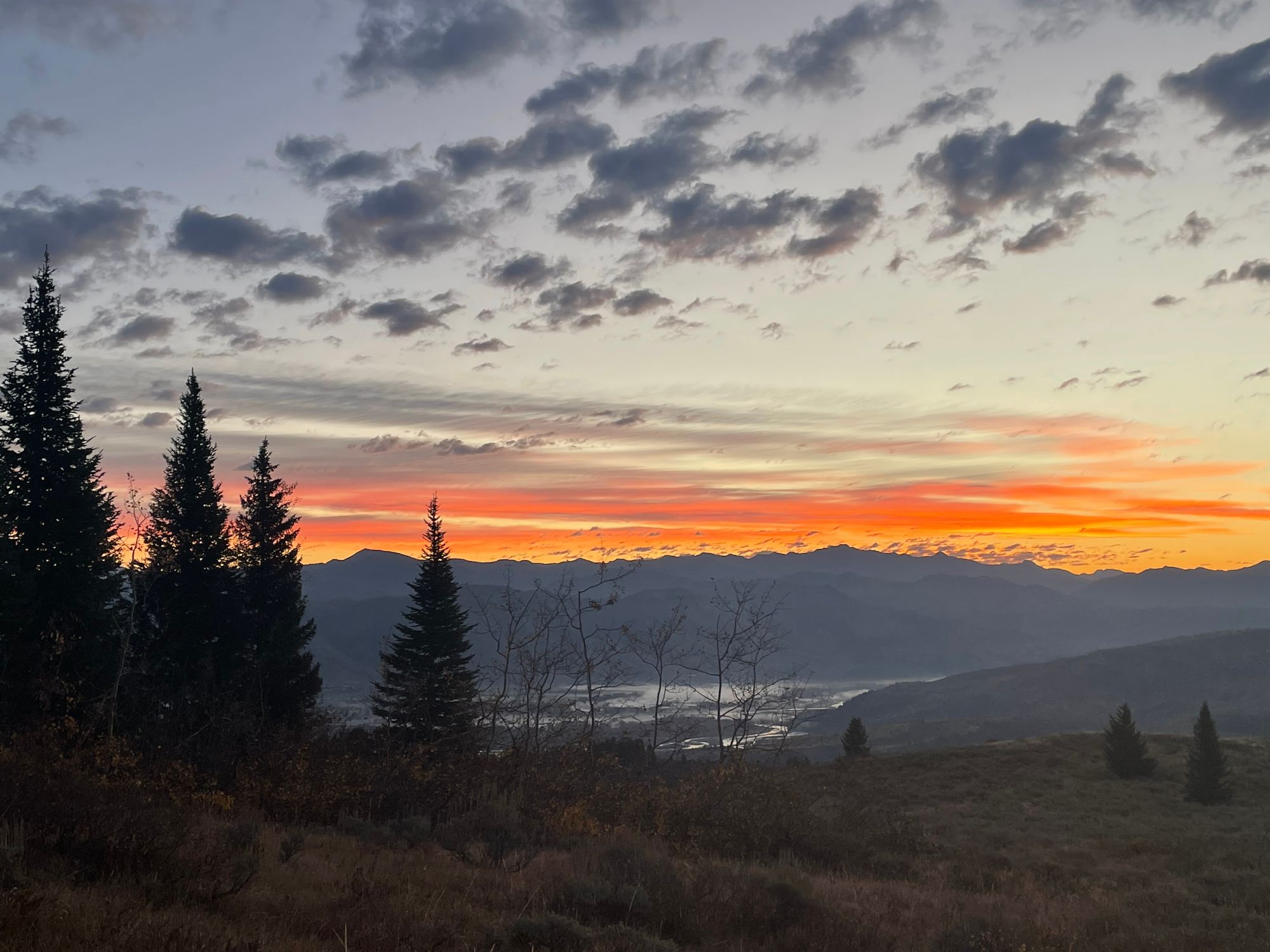
First light to dawn
I approached the Taylor Mountain summit as light began hitting the Tetons to the north. It was a clear morning, so I could see Jackson and Snow King to the northeast, the Tetons to the northwest and South Park in the foreground.
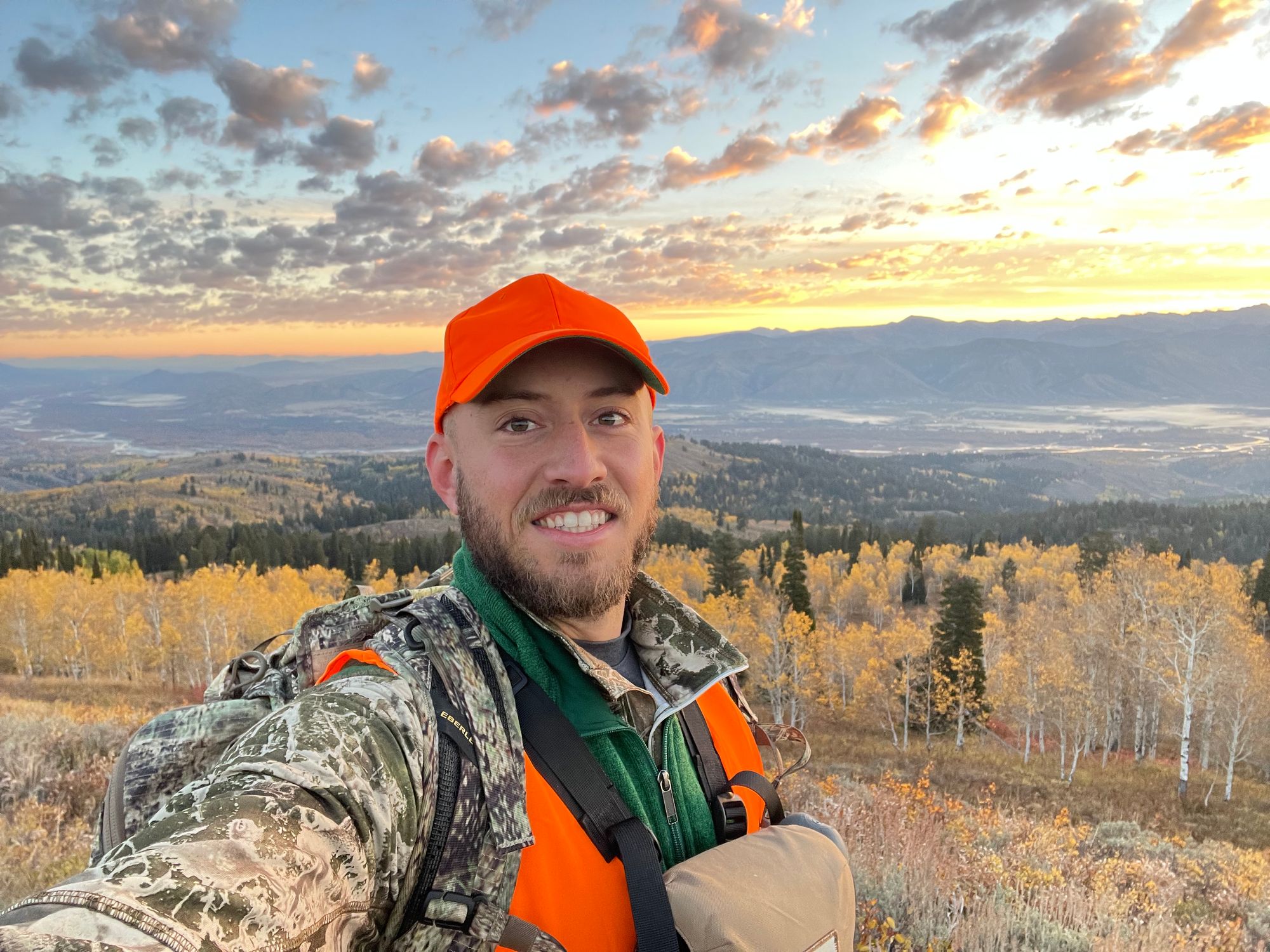

Sunrise
I was surrounded my yellow Aspen groves, tips glowing as the sun dropped from high summits in the Tetons to the foothills.
Beautiful views, but no sign of elk.

I kept hiking north along the trail. I spotted two cow moose on nearby ridgelines, but still no elk.
I found large game tracks next to a gully and snuck down to investigate. There was movement in the trees below, a large bull moose. I spent five minutes with him, then hit the trail again. Moose were off-limits in Hunt Area 85 and very difficult to obtain tags for in general.

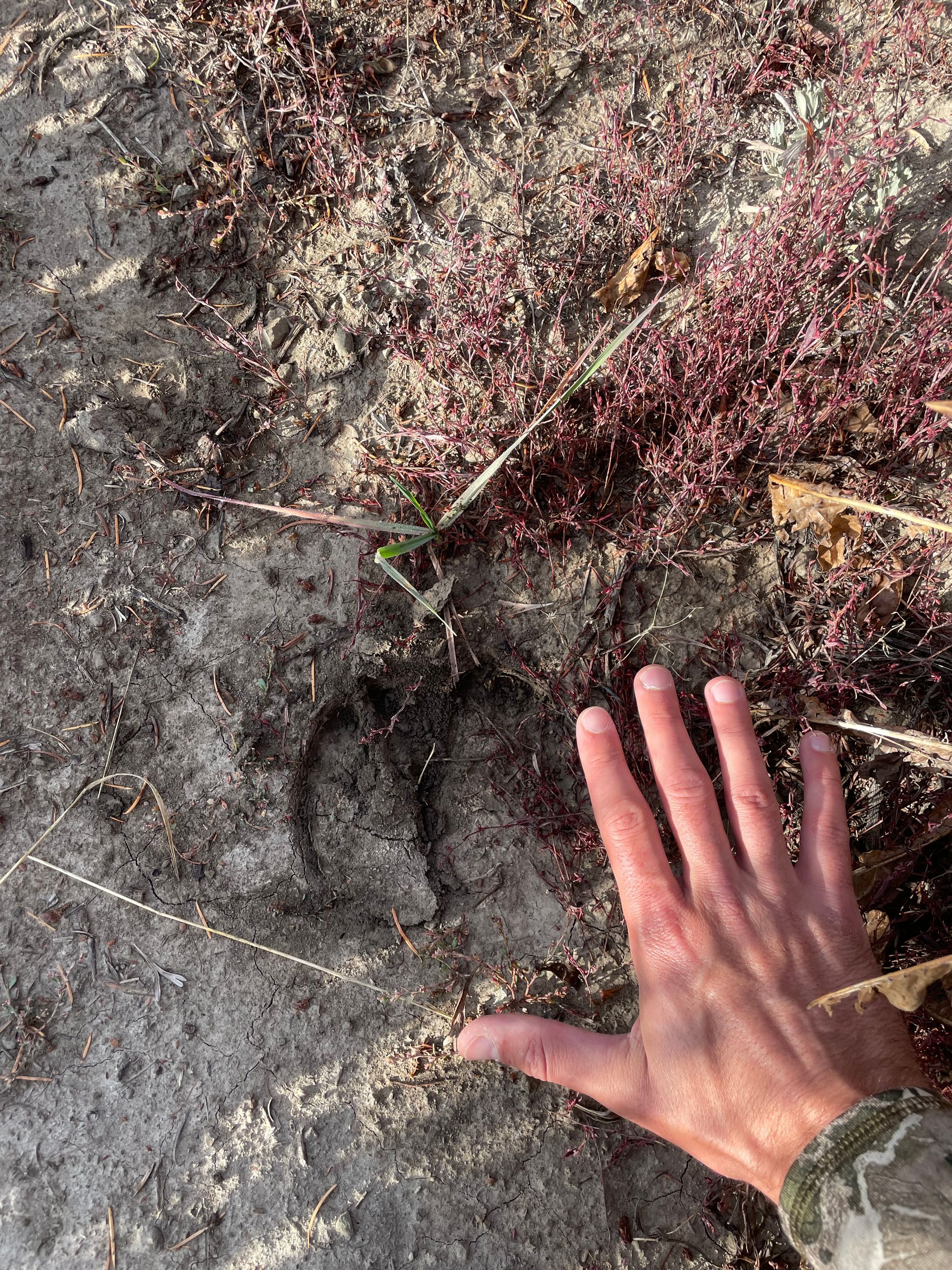

Tracking (left / middle); bull moose (right)
It was getting warm and I shed layers. After 4-miles of hiking with some detours along the way, I decided to turn back. It was ~11am and any elk in the area would likely be bedding.
I bushwhacked to the access road, which extended a couple miles past my truck parked at the Taylor Mountain trail. No sign of elk, near or far.
After descended down some loose rock above the access road, I was back on firm ground. Walking back to my truck, I spotted a mule deer at 130 yards on the opposite creek bank. Again, I found myself with the wrong big game license.
I wrapped up day one at 1pm. No luck hunting, but some stunning views and a special moment with a big bull moose.
I planned to hunt a few more days that weekend before flying to New York on the 14th, but those plans were scuttled by some visiting friends. I stashed the hunting gear, planning to wait for my Refuge permission slips in December.
Elk: 1 | Alex: 0.
Day Two
11/17/22
Back in Jackson in early November, we were blessed with big, early season snow storms. I moved my emergency gear into my backcountry ski pack for some early season laps on Teton Pass: Edelweiss and Mt. Glory to Coal Creek.
Then, I got tipped off to early elk migrations. With all the recent snow, elk started moving out of the mountains and into the Refuge. I applied for a few more Permission Slips just before the deadline and got three, giving me a ~week of hunting days starting in mid-November.
I shifted my emergency gear back to the hunting pack.
The Refuge gets crowded once the elk start migrating, so you need to be mindful of stray bullets. Hunter should never fire without a clear backdrop, but people make mistakes; others are straight-up reckless. (Don't forget a tourniquet.)
The buddy who lent me his rifle was free to join on the 17th. He planned to guide me to a hill that yielded him an elk in 2021. Hills in the north are generally safer than the flats in the south that offer little protection from bad shots.
The Elk Refuge is an anter-less zone: you can only hunt cows and calves.
In the winter, many elk stay on the Refuge day and night. But earlier in the season, herds migrate at night from the Nat'l Forest (where general tag hunting access is closed) to Elk Refuge feed grounds. Hunters aim to catch the inbound and outbound migrations at sunset and sunrise, respectively. During the day, you can also find some laggards bedding in trees on the Refuge.
There are archery / limited range zones in the south of the Refuge. A bit after the Flat Creek Road junction, any firearm can be used. The southern portion includes flats and Miller Butter; the remainder consists of hills in the north.
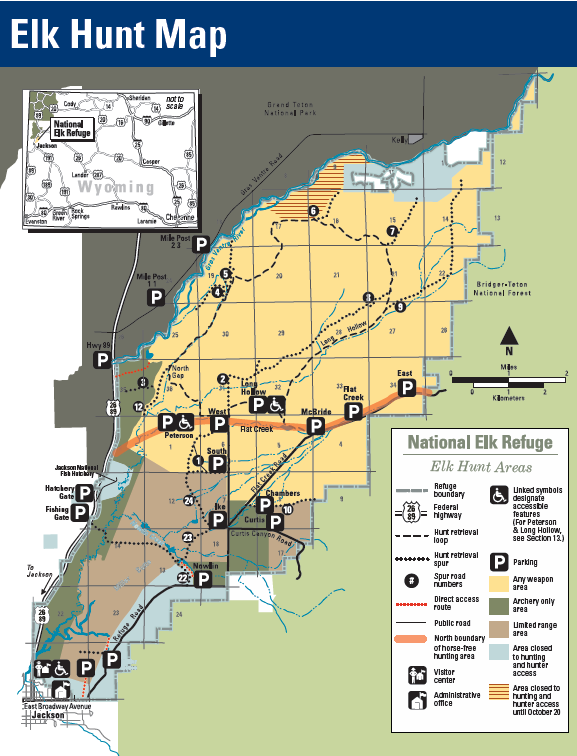

Refuge hunt map (left); our route starting at the East parking area (right)
We had a ~foot of snow in town, so I opted for gaiters over my pants and approach shoes. Plus, a puffer and Kinko's insulated gloves. Upside to snow: easier to identify recent game activity in snow.
I picked up my buddy at 6am. We grabbed breakfast sandwiches from Maverik and headed to the East parking area at the end of Flat Creek Road. At 6:45am, we started hiking north onto the plateau overlooking Long Hollow from the south. Thanks to daylight savings, sunrise was still 7:30am.
At sunrise, we spotted a herd of elk trotting out of Long Hollow in our direction. Unfortunately, all had antlers. ~30 bulls trotted within 100 yards, across the plateau and into the Nat'l Forest to our east. In the background, the sun slowly lit up the Tetons. No shot, but a spectacular scene.
Starting just before sunrise, gunshots started to ring across the Refuge. Dropping into Long Hollow, we passed one pair of hunters with a cow. They pointed out another cow in a cluster of trees on the opposing ridge. We started climbing.
As we ascended, we stayed in the cover of a knoll and used the cow caller to mask the crunch of our footsteps in the snow. By the time we cleared the top, she was long gone.
On the next ridge to our north, we spotted a small herd of cows bedding in a cluster of trees. We crawled out of sight and started approaching from a blind spot to their south. After 15min, we cleared a hill overlooking their position, but were still 500 yards away. While attempting to sneak closer, I spooked a cow hidden in brush 50 yards downhill. The whole herd took off.
We followed them two more ridges north, but they didn't give us a chance to get within shooting range. At one point, I bear crawled a hundred yards, immediately regretting gaiters versus snow pants (which I thought would be too noisy).
Realizing we were 4 miles from the truck, and that the herd would stay a few steps ahead of us, we trudged to the nearest access road. We practically walked to the Gros Ventre River in Grand Teton Nat'l Park.
Once you kill an elk, you're allowed to drive on access roads in the Refuge for recovery. Those roads are the path of least resistance back to the parking areas.
The return trip took a few hours. We passed two cow moose and some wolf tracks. My legs and feet were soaked and frozen from that bear crawl.
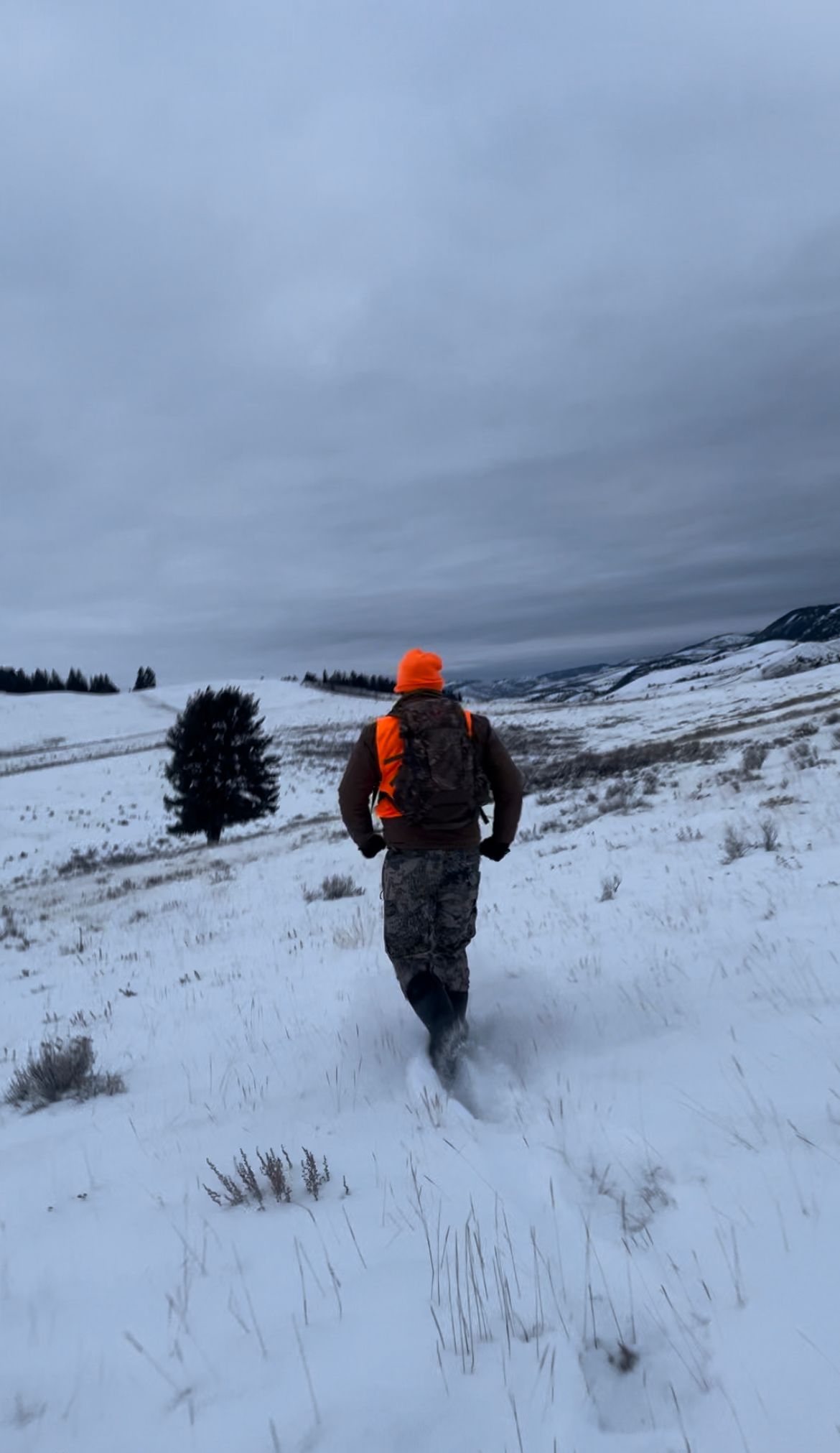

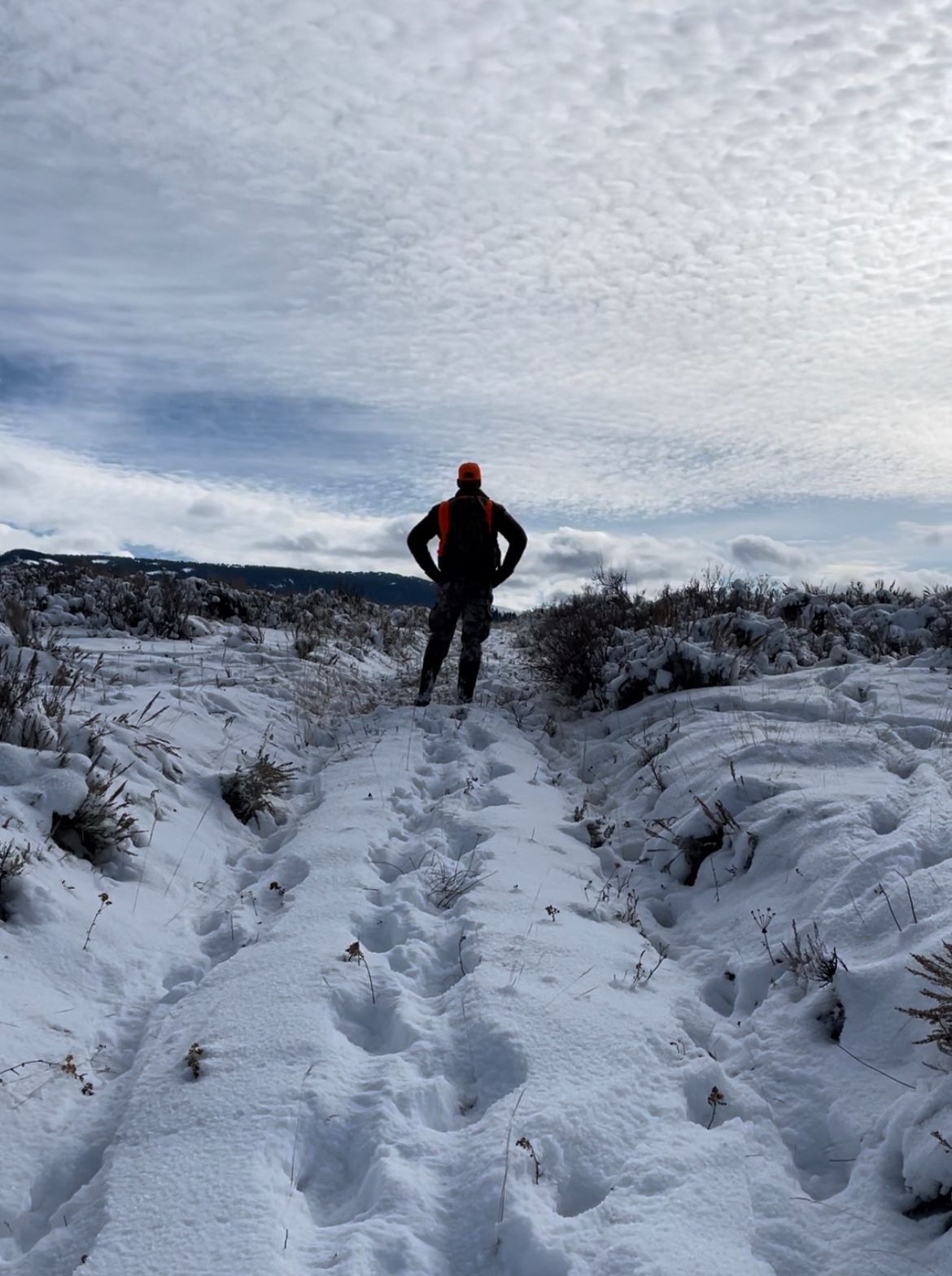
Sunrise on the plateau (left / middle); Return hike (right)
By 3pm, we made it to the truck and headed to Eleanor's for recovery beer and nachos. We only hiked 9 miles, but were wiped.
The next morning I woke up with a nasty head cold.
Elk: 2 | Alex: 0.
Day Three
11/20/22
I took a couple days to recover, then drafted a foolproof plan for day three.
Refining my gear from day two, I borrowed a friend's white camo ski jacket and dug out some old ski pants.
I also borrowed a fat-tire bike. On the day-two return hike, we noticed a heavily travelled game trail within 100 yards of a ridge that could provide cover for a shooter. That ridge was an easy bike ride along the Long Hollow access road. I planned to lay out a tarp and wait for the elk to come to me.
I left the McBride parking area at 6:45am with the bike and pack. Almost immediately, I stumbled upon a huge herd moving through Long Hollow.
Foolproof plan scuttled. I ditched the bike and hiked up the plateau, hoping to get a clear shot from the plateau.
Unfortunately, I couldn't find cover for the final stalk and the herd stayed out of range, even with a bear crawl. At least this time the snow pants kept be dry.
I retreated south below the ridge, then hiked northeast, hoping to cut off the herd before the Nat'l Forest. I made slow progress in the snow. A few hunters were ahead of me.
It was 7:30am. The sun lit up Grand Teton to the northwest. I entertained the idea of calling it, frustrated by my late start and skeptical I'd catch the herd. I trudged through snow, past the East parking area, where I wished I parked. There I picked up a foot travel-only USFS road north. The road cuts through the Nat'l Forest for about a quarter mile, so I unloaded my rifle to play it safe.
I chatted with one hunter recovering a cow from the prior night. He was waiting on tag & drag, a local service that drags your elk back to the trailhead for $100-150.
It was -5F, so moisture from my breath crystalized into my beard.



Bike / pack (left); Tetons (middle); white beard (right)
I finally cleared a ridge to the east of Long Hollow and met two hunters on horseback. They tipped me off to a herd in trees on the far side of nearby hill. I started hiking up a game trail on the hill's southeast slope.
As I hiked up the hill, I used the cow caller to mask my footsteps. I pulled the 308 out of my pack and chambered a round.
As soon as I cleared the ridge, I spotted ~50 elk within 100-150 yards. I hadn't spooked them yet, but brush blocked a clear shot. I inched downhill.
After a few steps, they spotted me and some scattered. A few stood still, straining for better look. One cow was positioned for a clear, broadside shot. Standing, I raised the rifle, aimed just behind her front-left leg and slowly applied pressure to the trigger.
As the gunshot rang out, the herd took off. After ~15 seconds of scanning, I spotted her carcass ~100 yards downhill from where she'd been standing.
I breathed a sigh of relief, knowing my shot was clean.
I approached the carcass, spotting her 5-foot slide path. She collapsed on her left side. I could see an exit wound just behind her front-right shoulder. Some bright red blood bubbled out, indicating collapsed lungs.
I prodded her with the rifle to confirm the kill. She twitched slightly, but not enough to warrant a second shot.
It was still subzero and the slope was shaded. First thing, I removed the tag from my pack, cut out the day / month slots and attached it to the elk via zip tie. (A legal requirement.)
My hands were frozen, so I called tag & drag. They had a horse / rider in the area and quoted $150 for the retrieval—a bargain versus the hassle of quartering. Plus, I'd get more meat off a full carcass.
I took some pictures. To warm up, I gulped coffee from my thermos and walked over to a sliver of sun 50 feet away from the carcass.


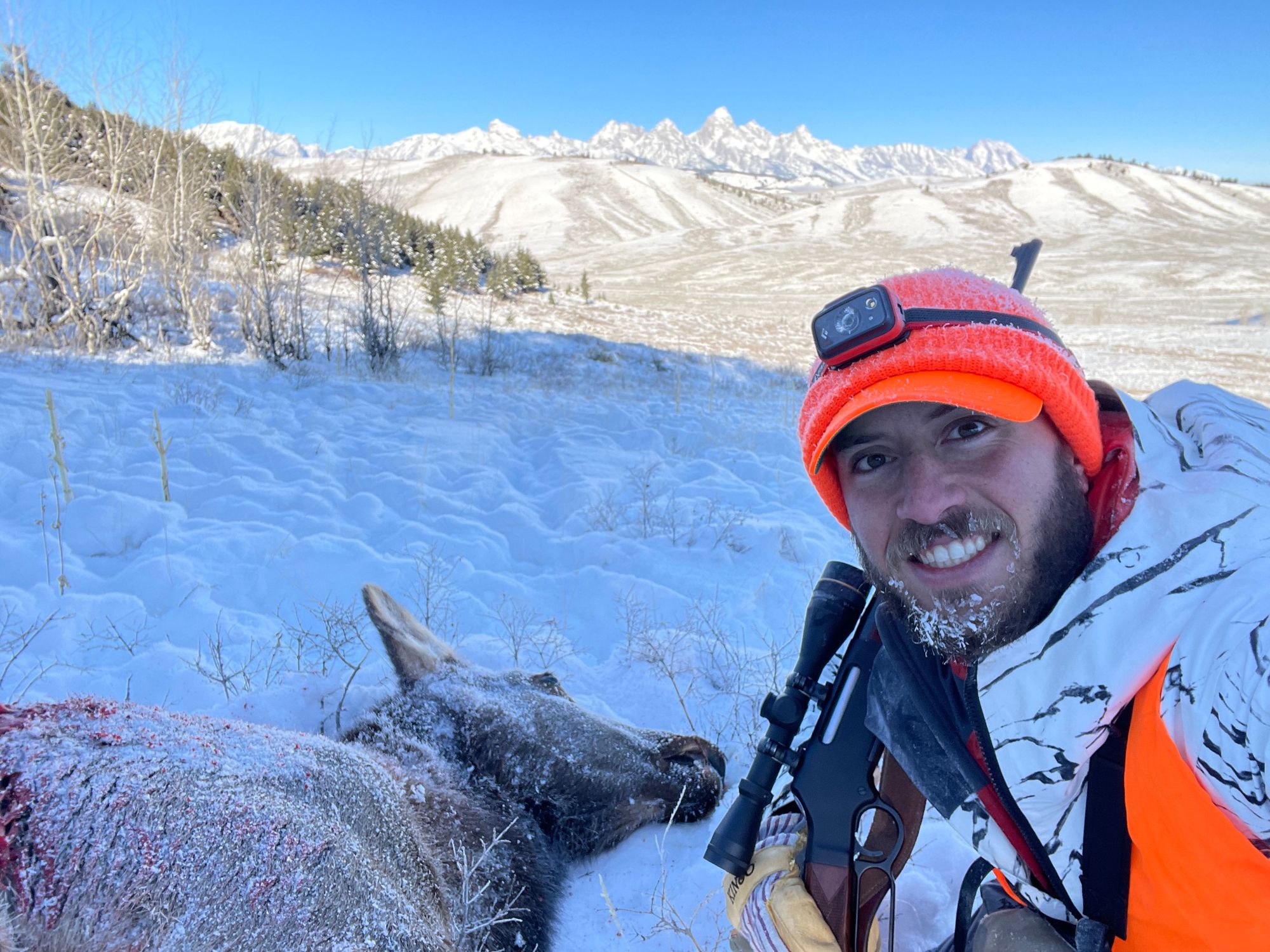
I warmed my hands as best I could, then resigned to the shade to gut the carcass. I spent more time studying quartering than gutting, so I was a bit shaky on the steps. I had cell service and got my Dad on speakerphone for tips.
I was about two-thirds through gutting when tag & drag rode up. The rider gave me a few final tips: cut the diaphragm and position the belly downhill.
I pulled out the guts. The rider tied a rope around her neck, so his horse could drag her back to the trailhead. I followed in their trail.
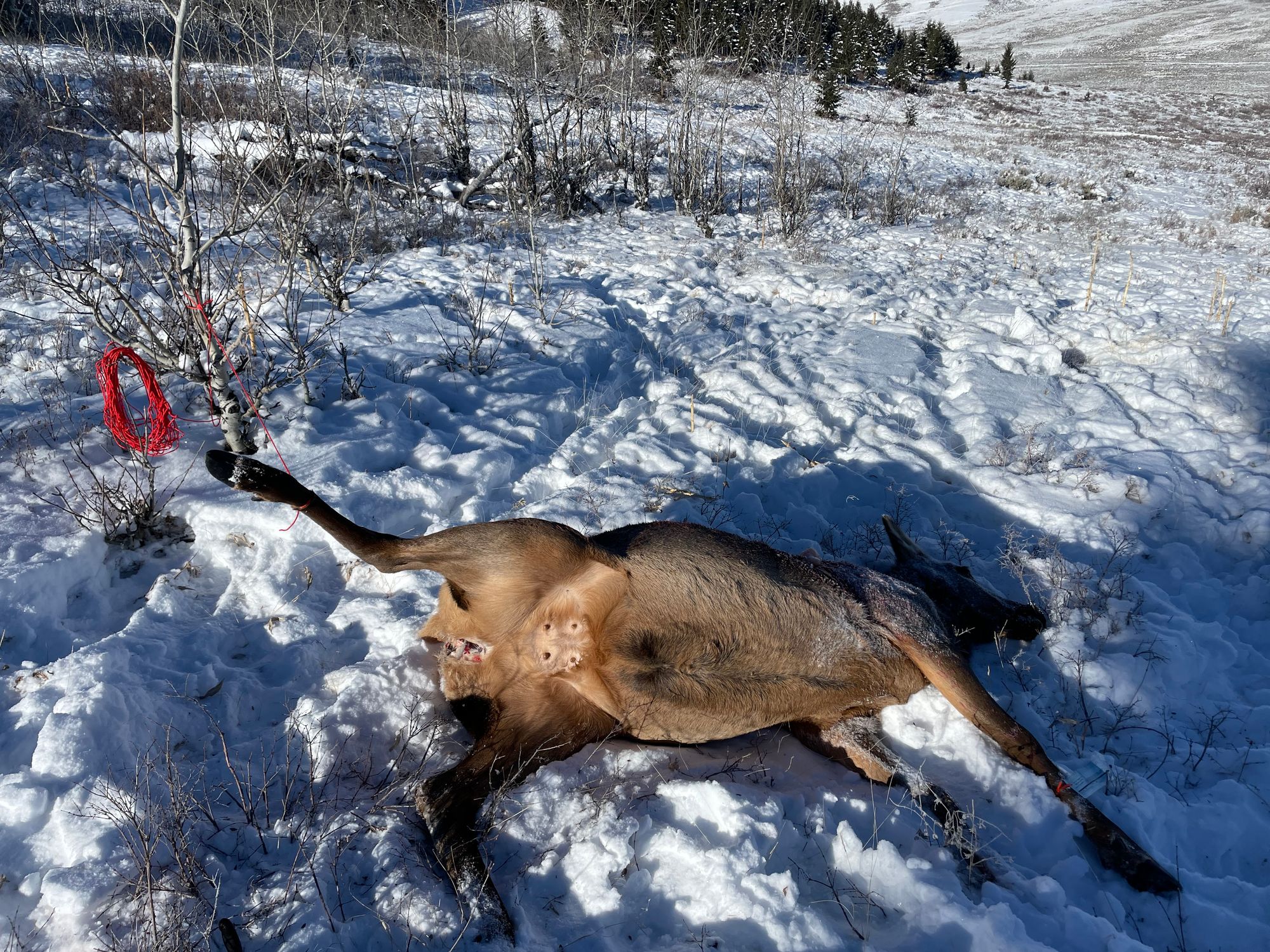
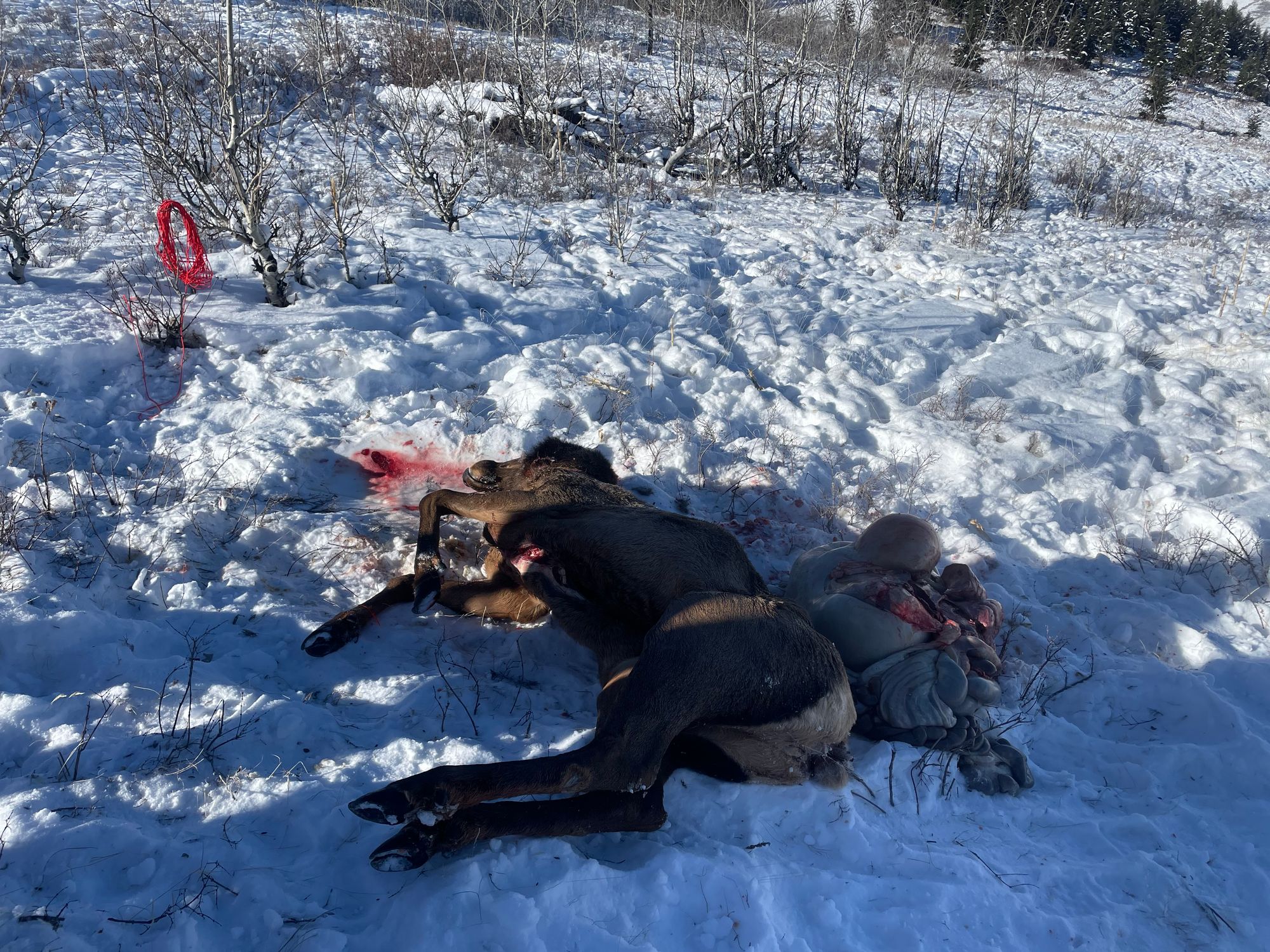
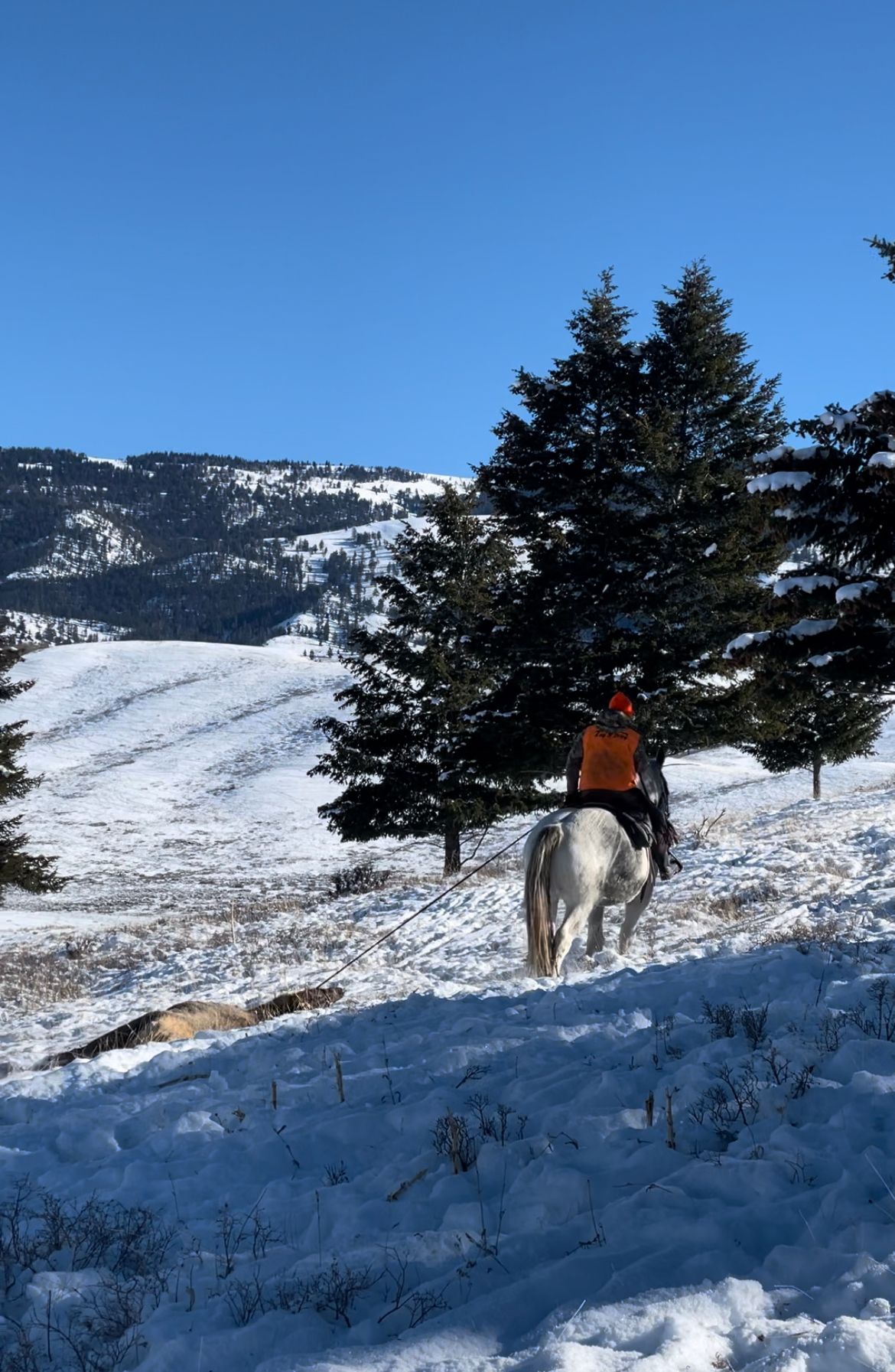
Gutting (left / middle); tag & drag (right)
The rider shuttled me back to my truck at the McBride parking area, then we drove back to East parking to load the elk. Another hunter pitched in, lending a plastic sled to lift the cow into my truck. She weighed ~300 pounds gutted.
Tag & drag left and I shifted to CWD testing (chronic wasting disease). The State maintains bins at each parking area for head collection. Alternatively, hunters can remove lymph nodes and send them to the lab. It was a cow, so I didn't plan to keep the head for a European mount.
There's no reported case of CWD transmission to humans through food. But, the CDC still doesn't recommend eating a CWD-positive animal.
The hunter who helped us load suggested I recover the elk's ivory, two canine teeth in the upper jaw. I cut them out, then borrowed his hacksaw to remove the head. I wrote my tag info on a paper slip next to the bin, attached it to the head and dropped the head in the bin. The State's lab would use that info to link test results to my account within a couple weeks.
The cow just fit in my truck's 6-foot bed. I chatted with the other hunter for a few minutes, closed my tailgate and drove back to town. At the Refuge exit in East Jackson, I filled out an info form that the Refuge requires after a successful harvest and dropped it in their collection bin.
I drove to Matt's Meat (1655 W Berger Ln) in South Park. It was Sunday, but they had a crew at the loading bay hard at work. They pulled the elk out of my bed.
I filled out an order form specifying cuts, chop meat, breakfast sausage, jerky and snack sticks. I had 5% fat added to the chop meat, which I would've skipped in retrospect (came out a bit chewy). Overall, it's a great bargain at $600 for 150lbs of meat, or $4/pound.
At my Dad's suggestion, I asked to keep the hide, planning to get it tanned. I waited 15 minutes for the butchers to skin the cow. I read a few articles about hide tanning online, all of which cited fleshing and salting as mandatory immediate steps. With my fresh hide in a cardboard box, I headed to Smiths for some non-iodized salt. (Some risk of discoloration from iodized salt.)
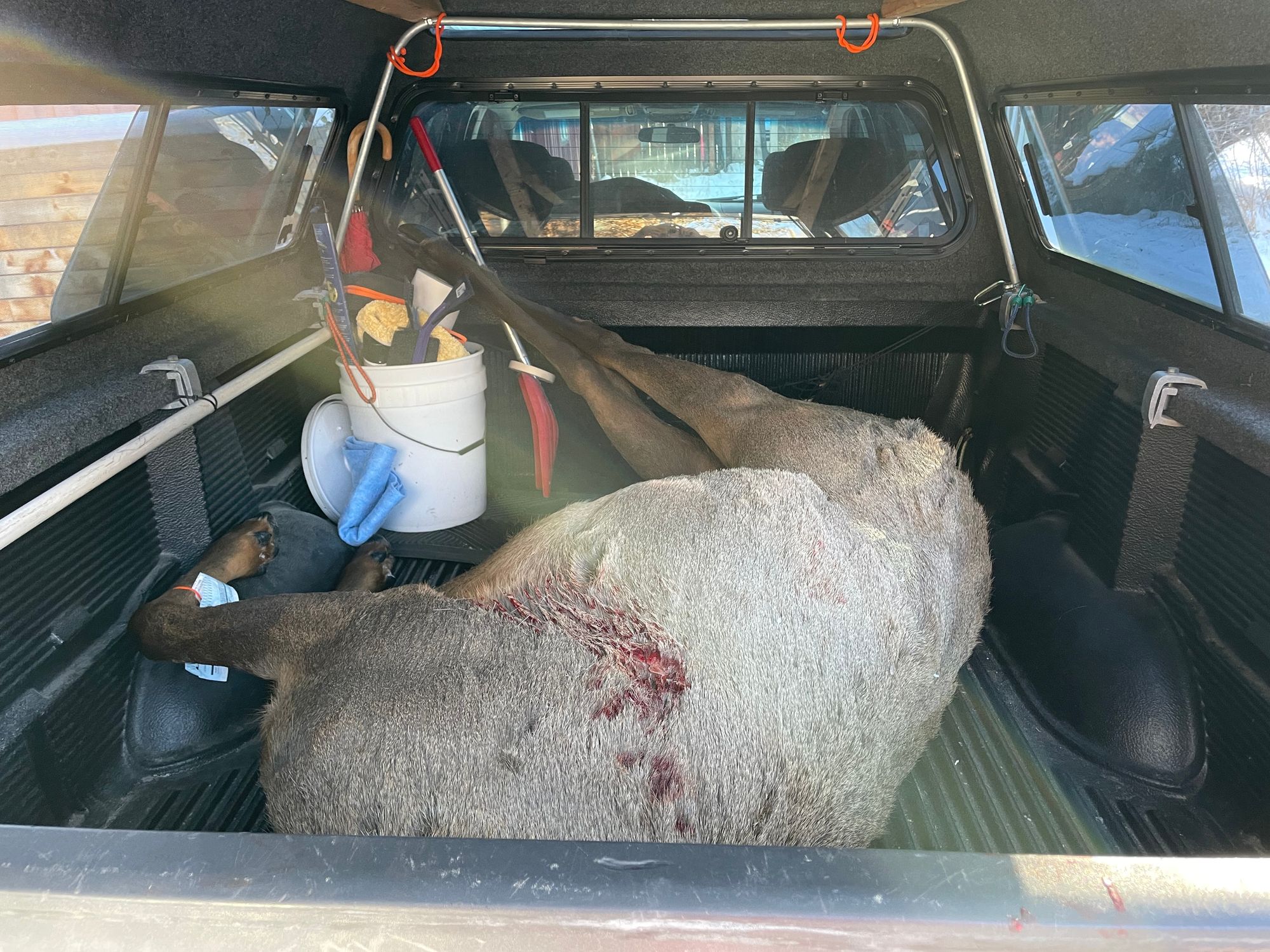
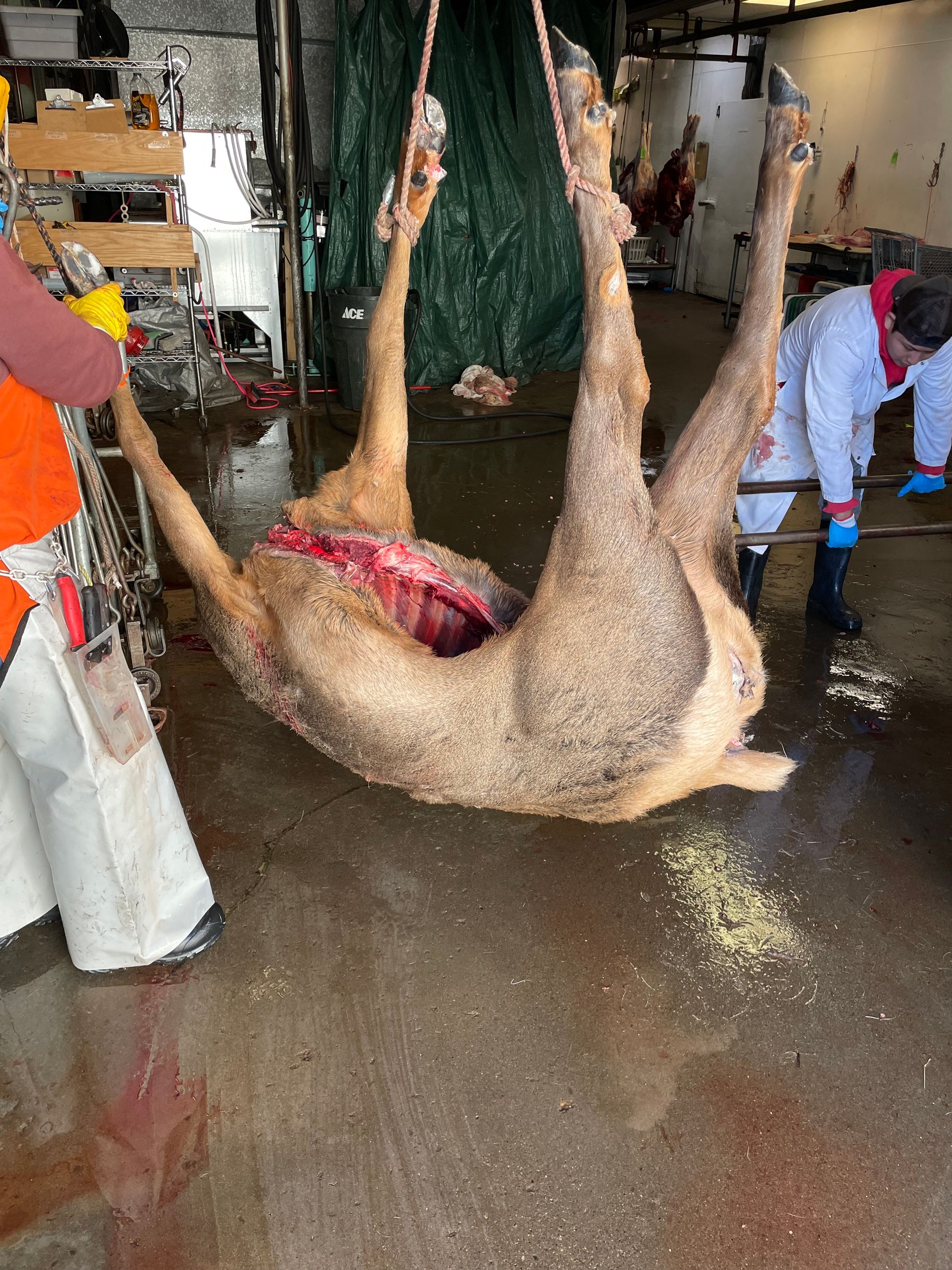

Transport (left); butcher (middle); hide (right)
I spent 5 hours removing as much flesh and fat as possible with my hunting knife and some pliers. Then I poured a few pounds of salt onto the stretched out hide, laid on a tarp in the garage.
Fleshing removes organic matter prone to rot and salt draws out natural fluids to be replaced by preservatives in the tanning process.
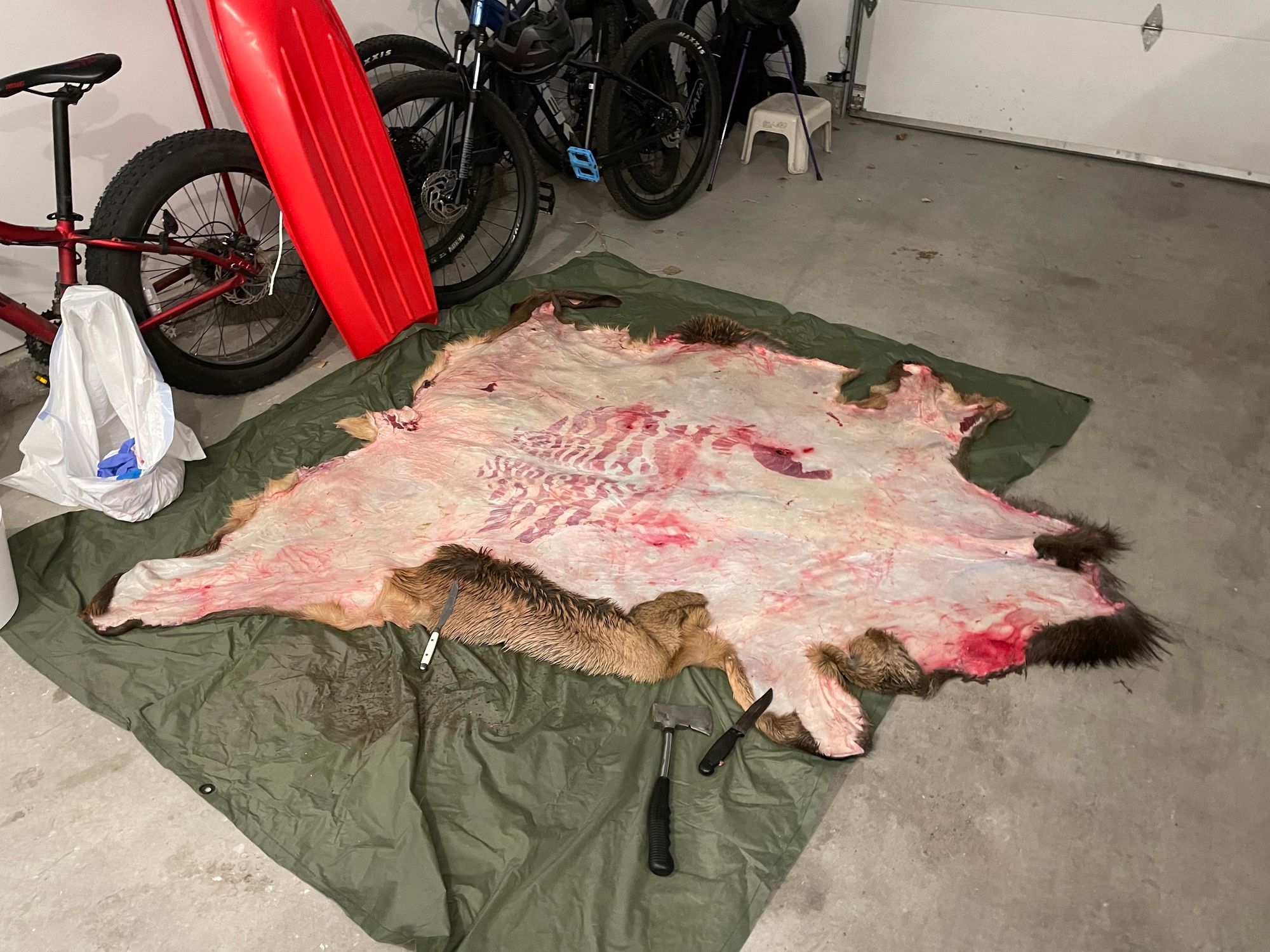


Fleshing (left); salting (middle / right)
I soon learned taxidermists are expensive and tough to pin down. So, I was stuck tanning the hide myself. Check out the full how-to article on elk hide tanning.
Within a couple weeks, I got negative CWD test results. A week later, I picked up the processed meat from Matt's and filled a new 5-cubic foot freezer to the brim. Tenderloins, ribeye's, NY strips, roasts, burger meat (5% beef fat), breakfast sausage and stew meat, plus jalapeno snack sticks and peppered jerky.
Stay tuned for articles on my favorite elk recipes. Teaser: crunch-wraps, shepherd's pie, thin-sliced steak over homemade potato chips and breakfast quesadillas.
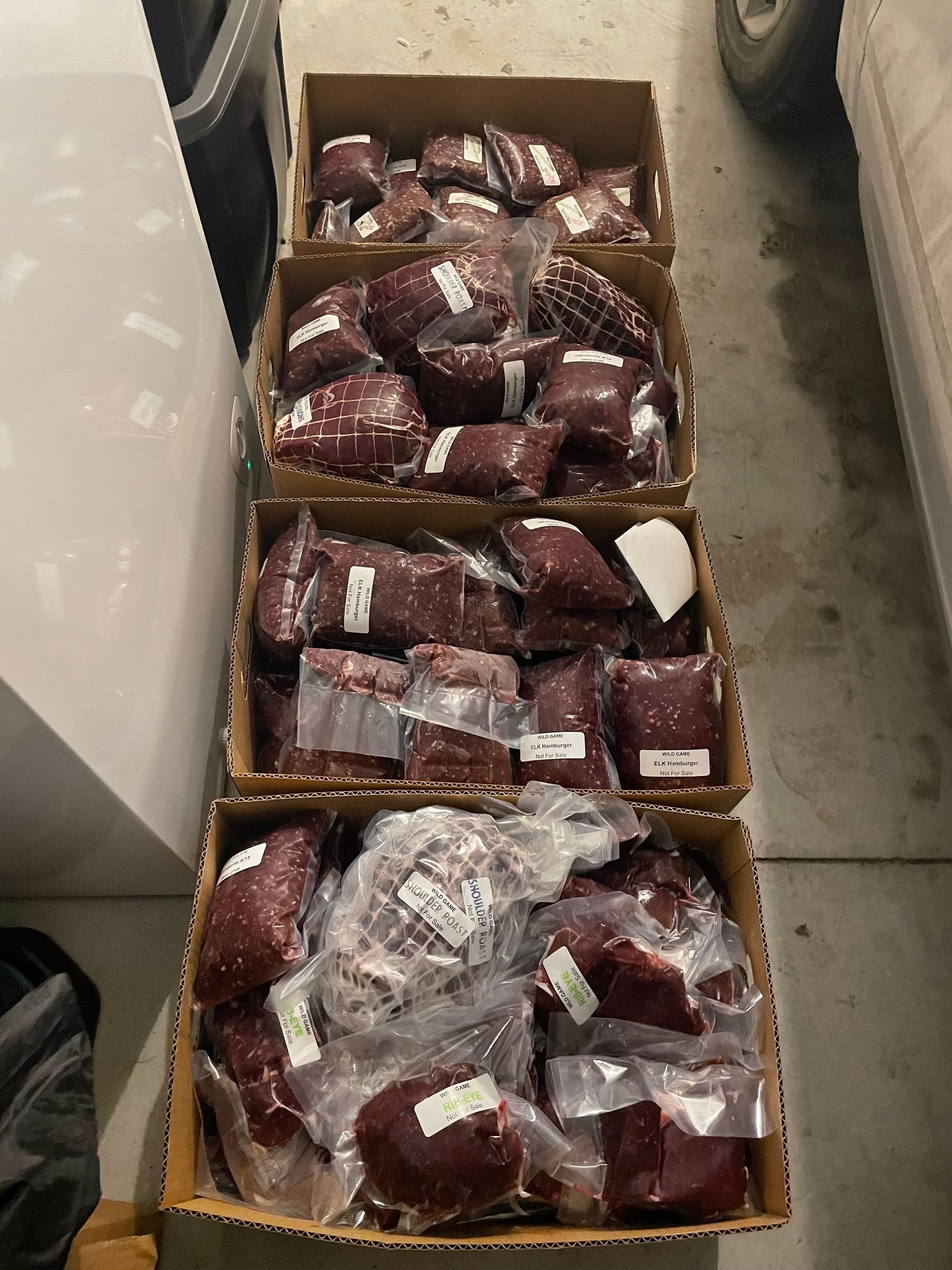


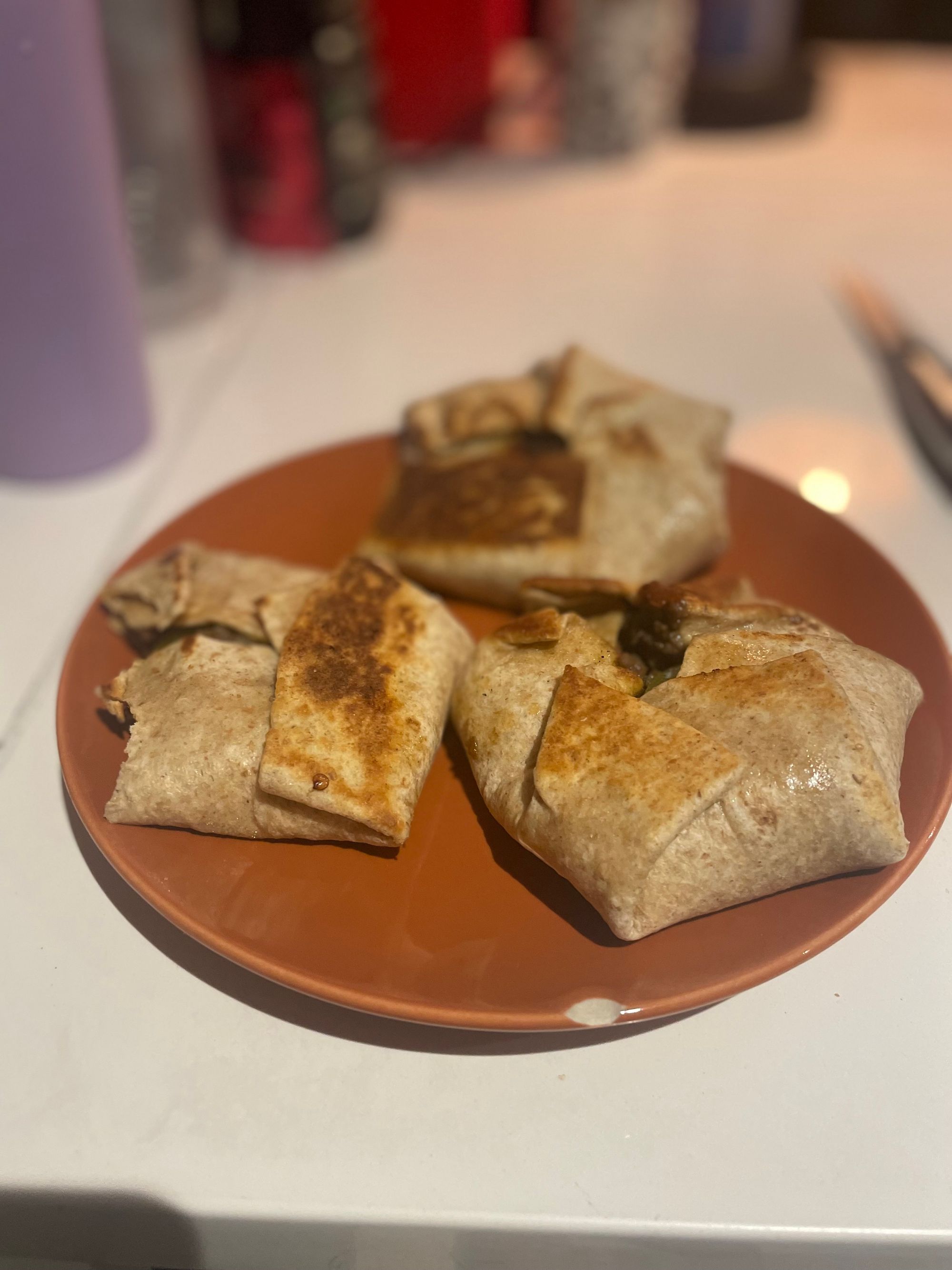
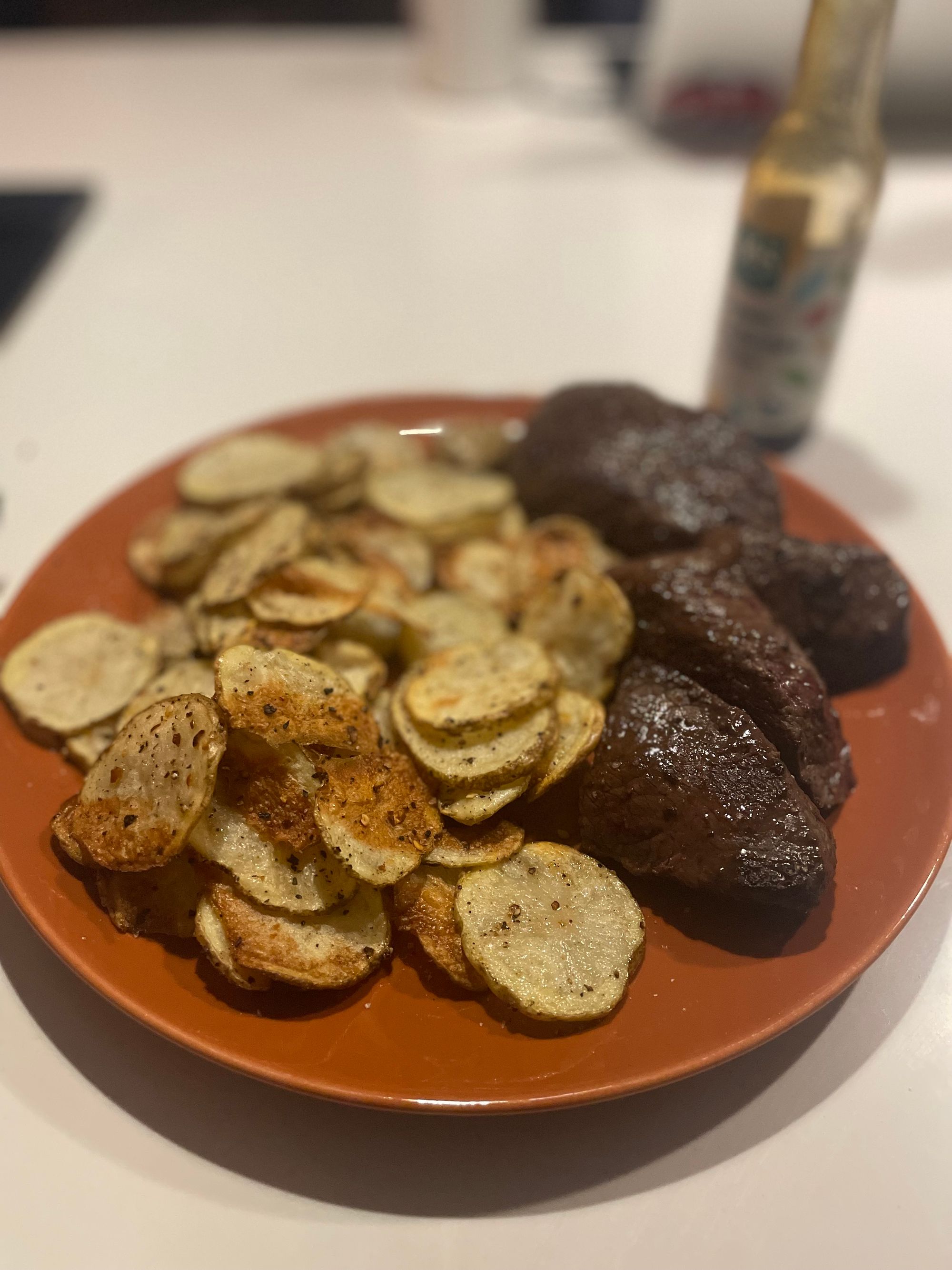

Frozen meat (top left / middle); steak app (top right); crunch-wrap (bottom left); steak (bottom middle); shepherd's pie (bottom right)
Elk: 2 | Alex: 1.